Lepiota mushrooms are incredibly diverse and very challenging for North American foragers. There are roughly 400 species recognized worldwide, and most are whitish, with white gills and a white stem. They are hard to differentiate from dozens of other mushroom species that share these characteristics. And, it’s difficult to distinguish them from each other. They are commonly called dapperlings because their appearance is often quite attractive, like a well-dressed person with nicely arranged scaled caps and rings. (Dapper isn’t used much anymore to describe people, but it was quite common decades ago and means “well-dressed, sharp, and tidy.”)
There are a few things, though, that can set a Lepiota species apart from lookalikes (including similar ones in the same genus). It does require that you really, REALLY pay attention to the details, and you’ll probably need to do a spore print. In many cases, it is the process of elimination that determines you’ve found a Lepiota mushroom.
- Scientific Name: Lepiota sp.
- Common Names: Dapperlings, Parasols
- Habitat: Varied but always grow from the ground
- Edibility: Not recommended due to the trickiness of exact identification, and because some are very dangerously toxic

Jump to:
All About Lepiota Mushrooms
The Lepiota genus is the primary home for what are called “lepiotoid mushrooms.” But it does not include them all. It’s all very complicated. Lepiotoid means “like Lepiota,” so the mushrooms that are in other genera share features with Lepiota and were probably in the Lepiota genus at one point, but then got moved to another genus for other reasons.
Because of this, there are now “true” Lepiota species and adjacent species that are similar, and considered lepiotoid, but are not actually Lepiota. Some of the most well-known lepiotoid mushrooms are not actually in the Lepiota genus. Some mushrooms can be really complicated!
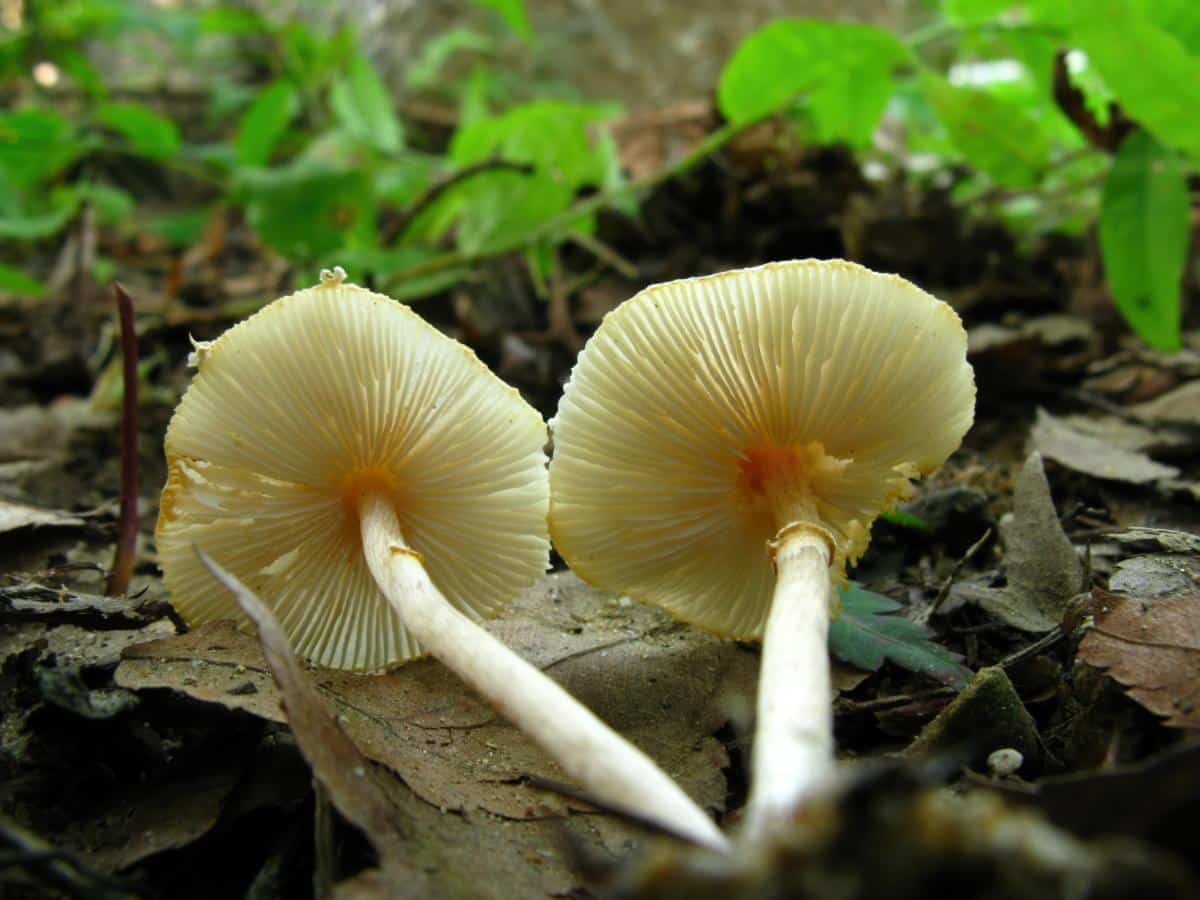
What Makes A Lepiotoid Mushroom?
Lepiotoid mushrooms have:
- white to cream-colored spore prints
- free gills (not attached to the stem)
- scaly caps that stick firmly to the surface
- partial veils that cover the gills when young, and when the veil breaks, it leaves a ring around the upper stem.
- caps usually measure 1-4 inches across
- grow from the ground (not on wood or trees) – they are saprobic, which means they break down dead organic matter
Most lepiotoid mushrooms used to be in the genus Lepiota. If you have an older field guide, it might still have this name. But today’s Lepiota is different from what it used to be. Microscopic studies and DNA tests have changed the classification of the genus, leaving us with a smaller main group of mushrooms that are the “real” Lepiota species. The ones that were pushed out of Lepiota were moved to Cystolepiota, Macrolepiota, Leucoagaricus, Leucocoprinus, Chlorophyllum, and a bunch of other genera. The species in these other genera are still considered lepiotoid, but they are not Lepiota. How’s that for confusing!
Lepiota (in the narrow sense) mainly consists of smaller mushrooms with brownish scales that form concentric patterns as the cap expands. The mushrooms previously known as Lepiota include:
- Leucoagaricus (Leucocoprinus) species such as L. leucothites (formerly L. naucina), an all-white lawn mushroom. Leucoagaricus species are typically larger, might have a club-shaped stem, and can stain yellow or red when bruised, and are not known to be deadly
- Macrolepiota mushrooms are much larger species like the edible Parasol Mushroom (M. procera).
- Chlorophyllum species are also larger and chunkier. The problematic false parasol, Chlorophyllum molybdites, has a green spore print which easily sets it apart. Other Chlorophyllum species have white spore prints, so that can’t be the sole determiner.
- Leucocoprinus species grow exclusively in tropical environments however numerous species have become a common sight in plant pots and greenhouses. This has made them known worldwide.
- Cystolepiota are small whitish mushrooms that are often covered with a powdery dusting or scales.
We’re not going to dive in too deep; we’ll leave that for the mycologists and DNA sequencers. This is just to demonstrate how convoluted and confusing the group is as a whole.
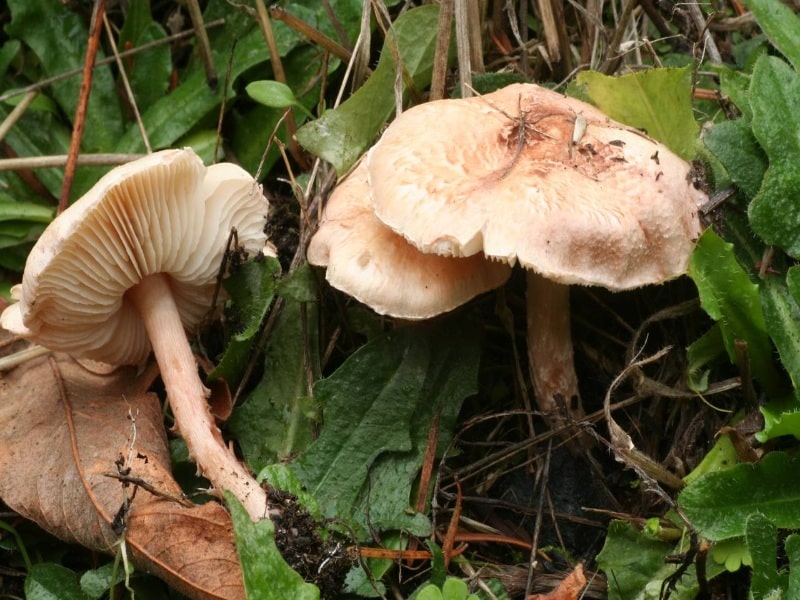
Lepiota Identification
Season
These mushrooms fruit after late summer rains and during autumn in temperate regions. They stop appearing when night frosts begin.
Habitat
Lepiota mushrooms are mostly saprobic. They break down dead organic matter in forest litter to help cycle nutrients in ecosystems.
These mushrooms primarily grow in areas that have been disturbed. They’ll fruit in deciduous and coniferous forests, mulched gardens, landscaped parks, and lawns. Lepiota cristata, one of the most common species, often grows in gardens, leaf litter, paths, and disturbed ground.
Lepiota mushrooms grow singularly, rarely in dense groupings or clusters. There are often many scattered around in one area, but each one grows on its own. Many species come back to the same spots year after year. Sometimes they form “fairy rings” that grow outward each season.
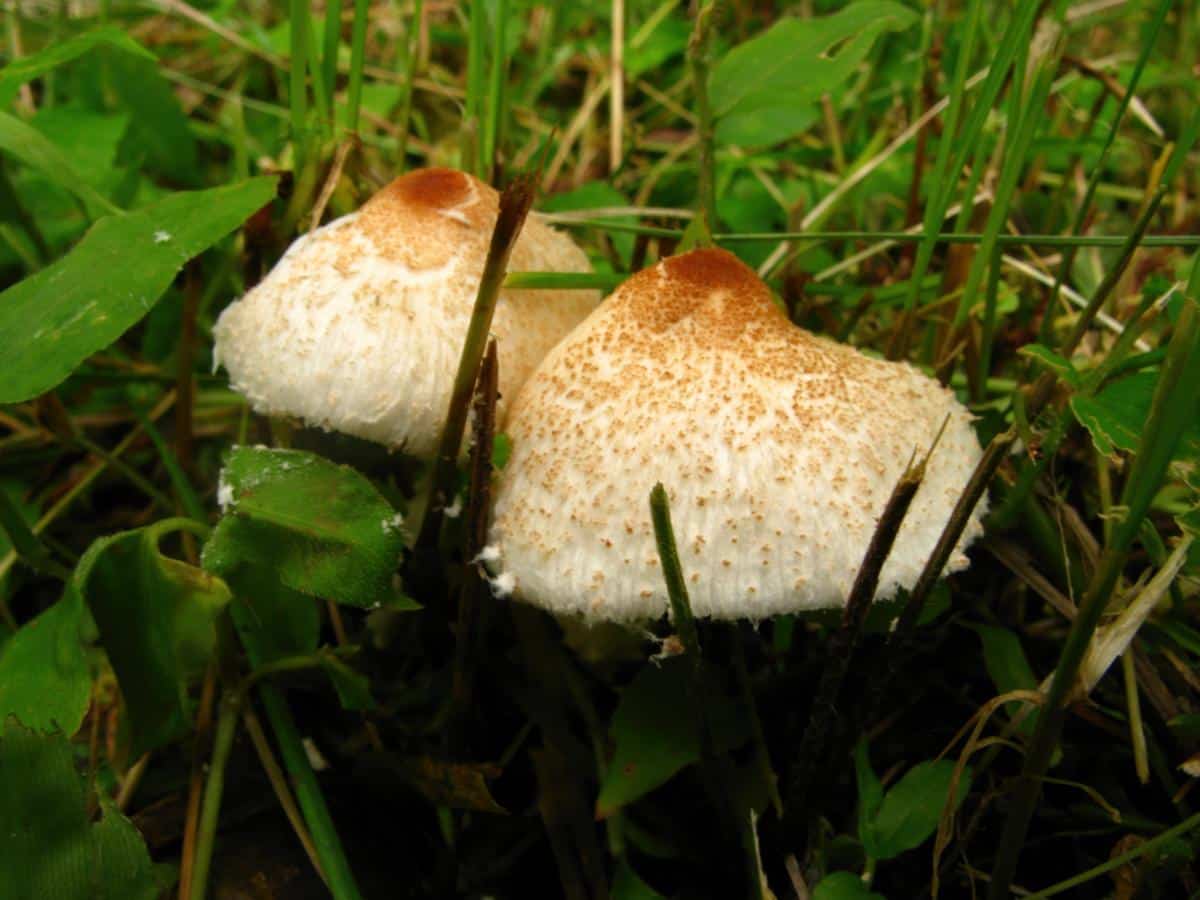
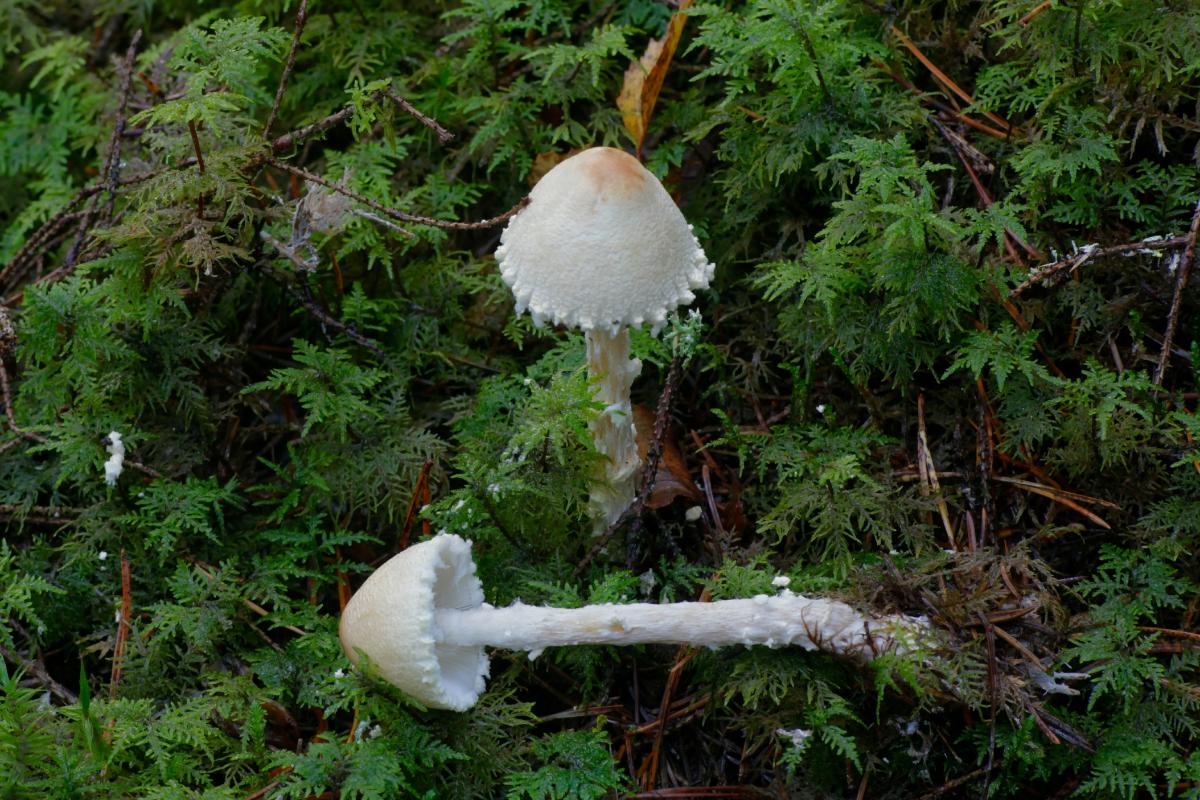
Size and Shape
True Lepiota species tend to be small, with caps usually spanning 1.5-4 inches across. Their stems are typically 3-7 inches long and are thin. When the mushroom is young, the cap is rounded like an egg, similar to the common button mushroom. As it ages, the cap expands and becomes bell-shaped before it reaches almost full flatness at maturity.
The majority of Lepiota mushrooms are white in color, with white gills. The caps often develop distinctive scales (squamules) as they grow larger (but not always). These scales stick firmly to the cap surface; you cannot brush them off easily like you can with Amanita mushrooms. The scale patterns range from neat concentric arrangements to random distributions, and the colors range from brown to reddish, black, or pink.
The center of the cap usually has a distinctive brown spot and the cap may be upraised slightly at that point, so it looks like a bump.
Gills
These mushrooms have free gills that don’t connect to the stem. These gills are white to cream-colored in young specimens but might take on different tints as they age. The gills are packed close together, and they often include many short gills that stop before reaching the stem.
Partial veil
Young lepiotoid mushrooms have a partial veil that covers their gills. As the mushroom grows and the cap expands, the veil breaks. The broken veil leaves a ring (annulus) on the stem. Ring patterns vary quite a bit – some look like skirts, others form collars, and a few appear as delicate zones. The ring’s texture might be membranous, cottony, or fibrillose, which helps with identification.
Spore print
All Lepiota species have white spore prints.
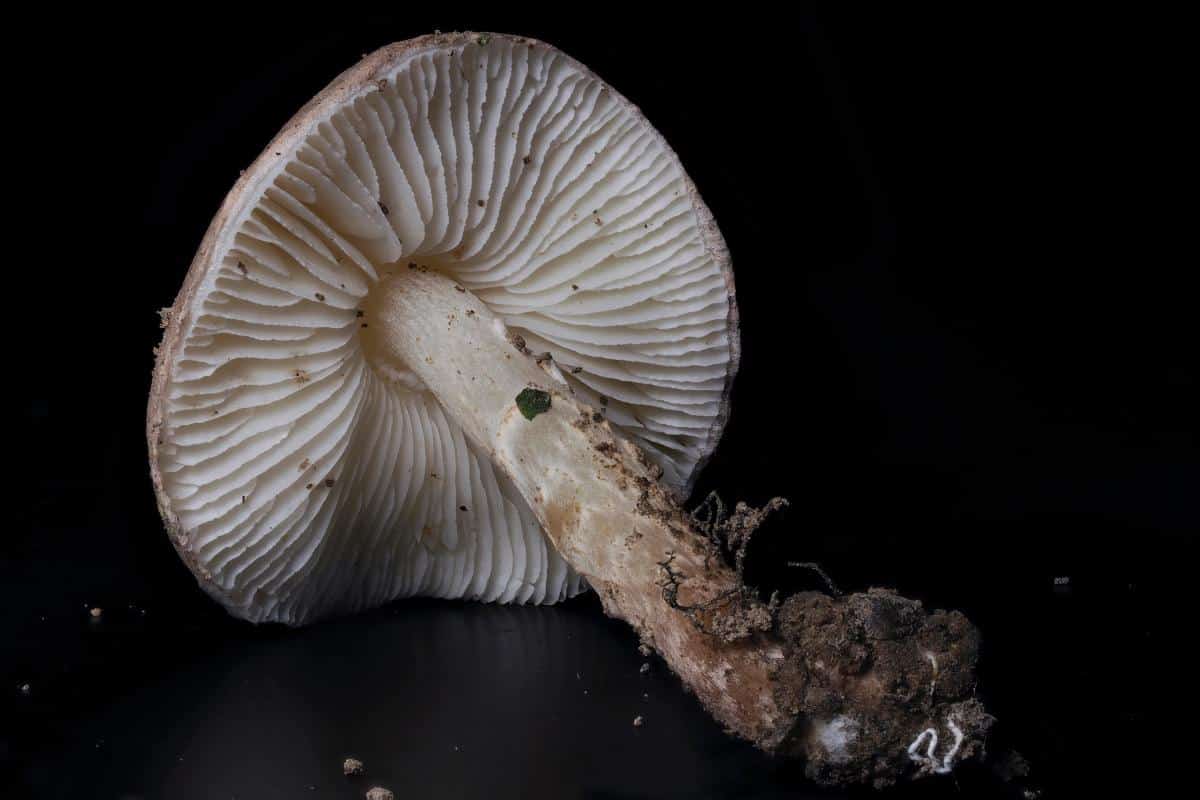
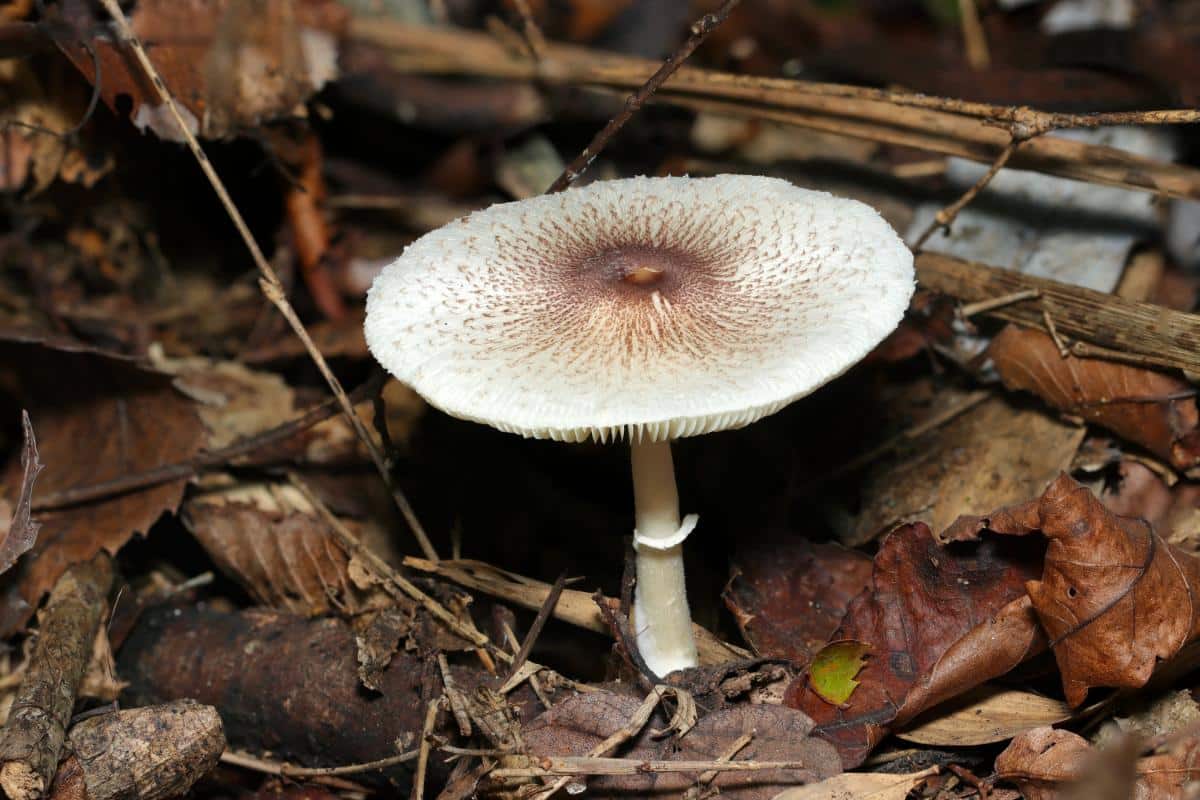
Dangerous Lepiota Species
Many small Lepiota species contain deadly toxins. Lepiota brunneoincarnata, L. subincarnata, and L. josserandii are extremely dangerous. These toxic species have caused many poisonings worldwide. The symptoms usually start 6-12 hours after eating the mushroom. Victims first experience severe stomach distress with abdominal pain, vomiting, and diarrhea. A misleading “recovery phase” follows before liver and kidney damage becomes clear.
The toxin inside these species is Amatoxin—the same compounds found in certain Amanita species. Amatoxins pose exceptional danger because they remain stable even after cooking. Cooking, drying, or freezing won’t destroy the toxin. Even half a mushroom cap can deliver a lethal dose that causes fatal liver damage.

Lepiota species in North America
Shield Dapperling (Lepiota clypeolaria)
This Lepiota has a bell-shaped cap with brown fibrillose scales. Its silkily fibrillose stem also has cotton-wool-like veil fragments on it, leftover from when the partial veil broke. This mushroom grows in deciduous and coniferous forests.

Stinking Dapperling (Lepiota cristata)
The stinking dapperling lives up to its name with a distinct rubber-like odor. It has a white cap that develops reddish-brown scales as it matures. The species grows in the woods, gardens, and areas with disturbed soil.

Dune Dapperling (Lepiota erminea)
The dune dapperling has a white cap with yellowish-brown tints at its center. This species grows throughout North America in sandy calcareous grasslands near coasts and sometimes inland.
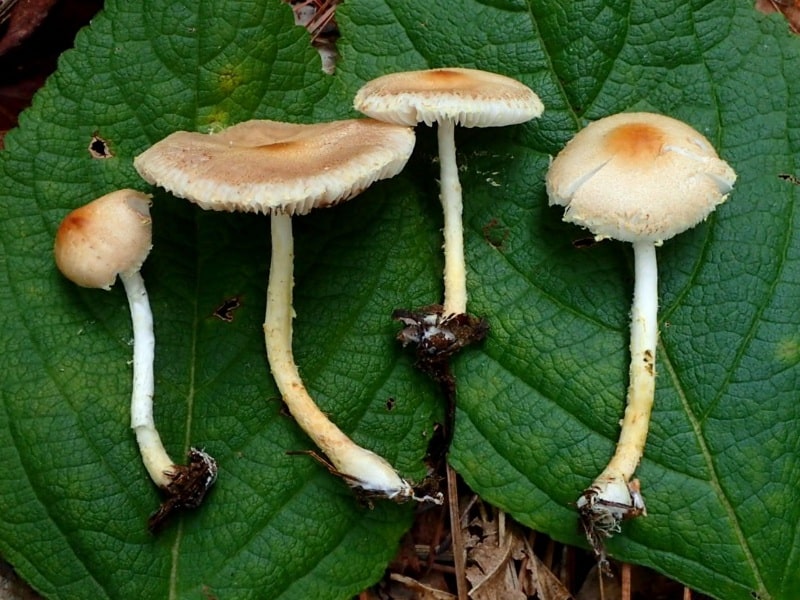
Cat Dapperling (Lepiota felina)
This elegant mushroom has a distinctive leopard-like appearance. The cap measures grows up to 1.2 inches in diameter and is white with a striking dark brown to black center and concentric rings of relatively large brown scales. It has a slender stem that is creamy white with a persistent ring that is cream above and brown below. This saprobic species typically emerges between July and October. It grows solitary or in small groups on the forest floor among conifers.
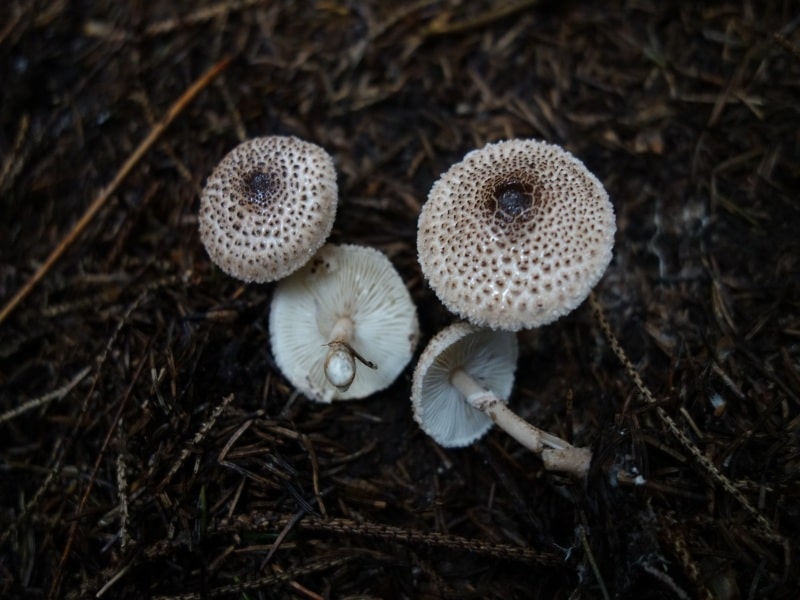
Lepiota lilacea
This small mushroom is not white like many other species. It has a lilac or pink stem and a purple-brown to dark brown cap center. It is one of the more dangerous species and can cause liver failure.

Yellowfoot Dapperling (Lepiota magnispora)
This Lepiota has yellowish scales on its cap. It also has a yellow-orange stem base, which is how it got its common name. It grows in broadleaf and coniferous forests across North America.
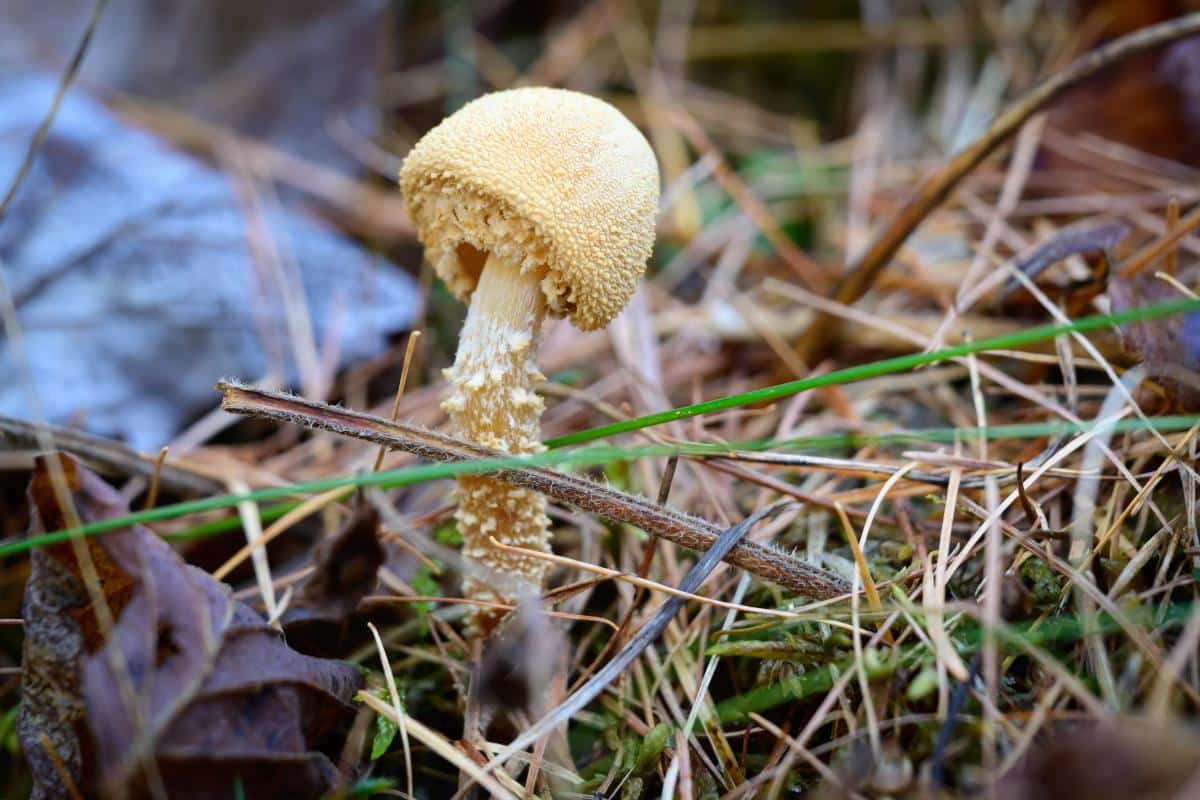
Fatal Dapperling (Lepiota subincarta)
The “fatal dapperling” or “deadly parasol,” has a small cap, up to 1.4 inches in diameter, with distinctive pinkish-brown fine woolly scales. These scales often form irregular concentric rings that become paler toward the cap edge. The mushroom has free, crowded, creamy-white gills and a slender, cream-colored stem with a slight pinkish tinge.
The stem surface is smooth above an indistinct ring zone, and below it is decorated with fibrous scales. This deadly poisonous species contains alpha-amanitin and is typically found in woods, richly soiled parks, and occasionally on lawns from July to November.

Lepiota Adjacent Mushrooms
Most of these were at one point in the Lepiota genus and were moved to other genera based on DNA and microscopic research. They are lepiotoid mushrooms, so they share many of the same features with true Lepiota species.
Macrolepiota procera (Parasol Mushroom)
This is a choice edible among dapperling mushrooms. The parasol is an especially impressive mushroom because it can grow up to 16 inches tall, with caps up to 10-20 inches wide. And, they often grow in large scattered groupings that literally look like a troop of mushrooms in the forest. This mushroom has brown scales on its whitish cap and a snakeskin-patterned stem with a movable double ring. The mushroom’s flesh stays white and shows no bruising after cutting.
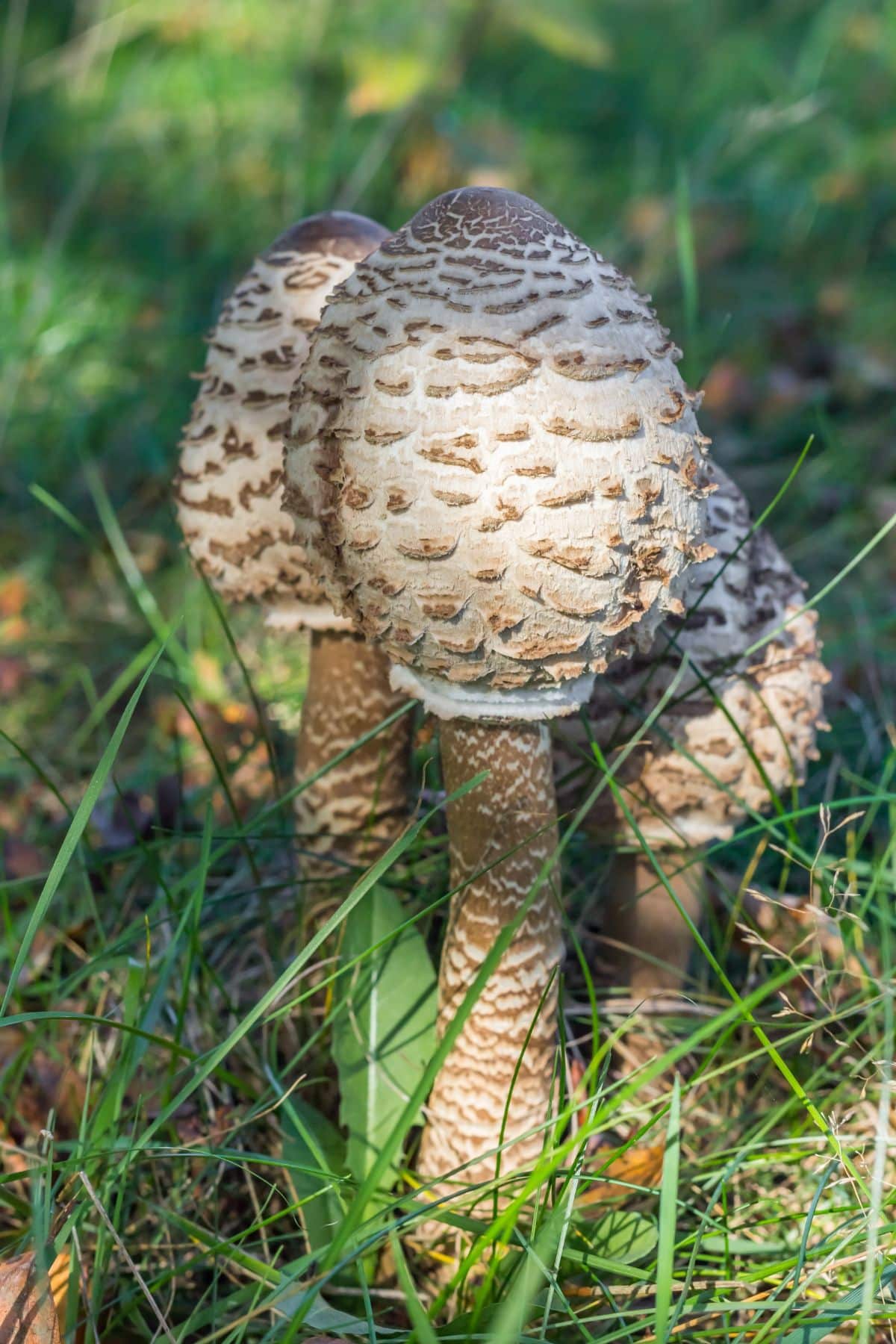
Chlorophyllum molybdites (False Parasol)
The false parasol causes more cases of mushroom poisoning in the United States than any other species. People who eat this toxic dapperling experience severe gastrointestinal symptoms that appear within 30 minutes to 2 hours. In the year 2018, there were at least 55 poisoning cases with 133 patients in China who accidentally consumed this mushroom. The best way to differentiate this mushroom from edible species is to do a spore print. It will be green, not white like other lepiotoid species.

Shaggy Parasol (Chlorophyllum rhacodes)
The shaggy parasol is also tall with a white cap, white gills, and shaggy scales on its cap. The cap, though, is very shaggy with dense tufts of white scales. It is an edible mushroom but can easily be confused with the false parasol. This species has a white spore print, though.

Smooth Parasol (Leucoagaricus leucothites)
The smooth parasol is large, dense, and all white. The cap is white, the gills are white, and the stem is white. It does not have shaggy scales of any sort or warts on the cap or stem. This easily sets it apart from many other related species.
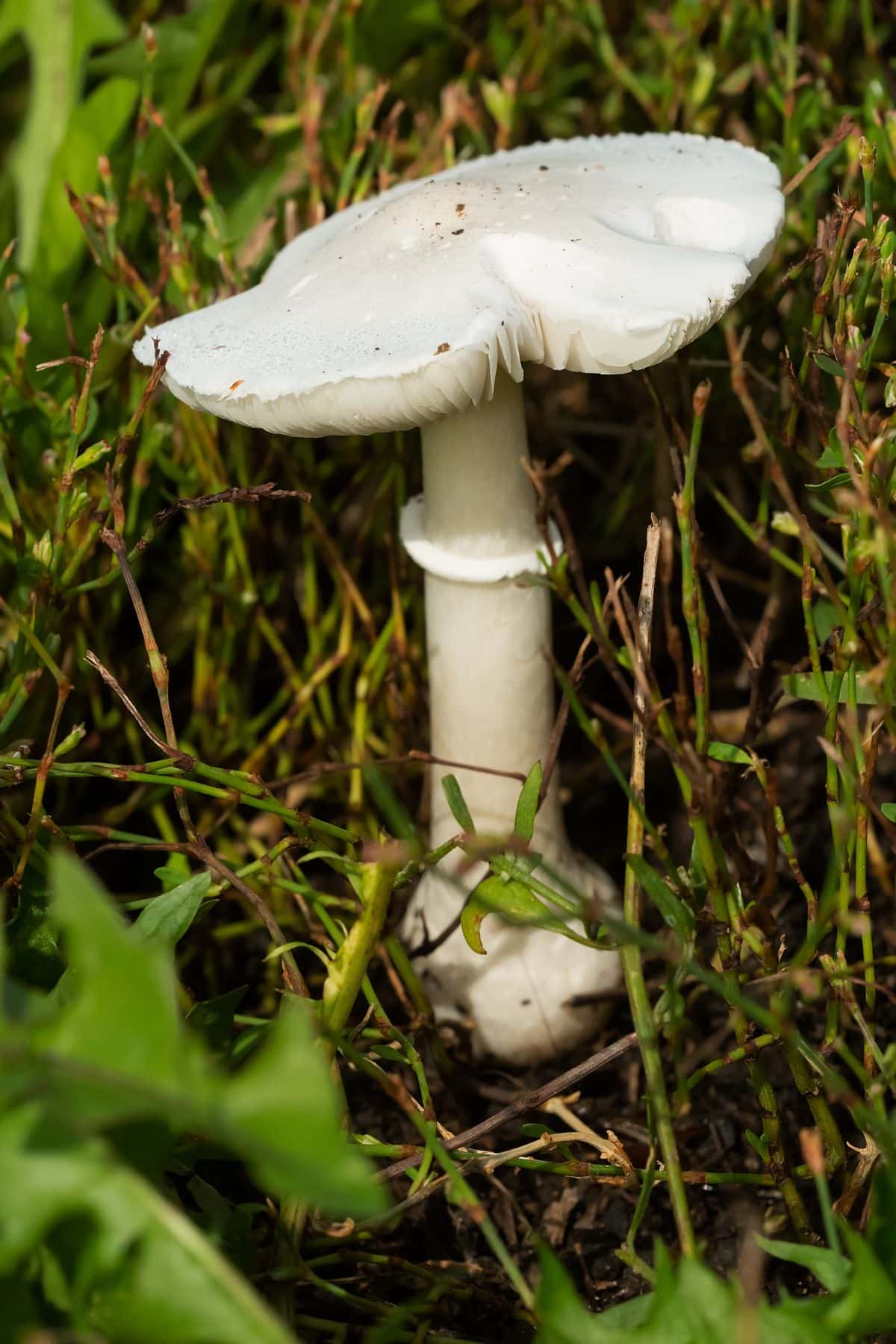
Freckled Dapperling (Echinoderma asperum, previously Lepiota aspera)
The freckled dapperling grows around 6 inches tall and has a brownish, warty cap. The brown warts are different from the brown scales from on Lepiotas, which is why it was moved out of the Lepiota genus. It also has brown scales on it’s stem, which another way to differentiate it from Lepiota species.
It mostly grows in woodlands and on bark chips in parks and gardens, and appears in autumn. Though some sources list it as edible, research shows it causes alcohol intolerance. It should be considered toxic (not deadly) and eaten with caution, if at all.
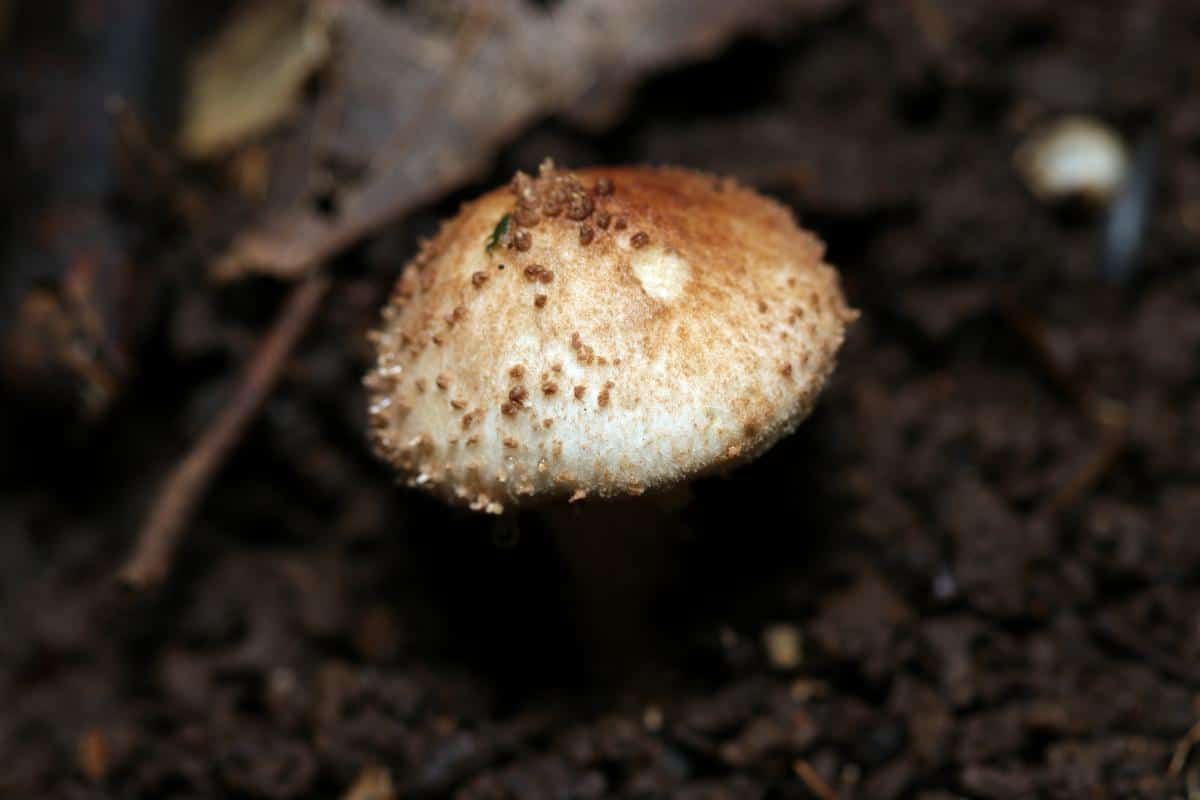
Lepiota Mushroom Lookalikes
Amanitas
Lepiota and Amanita mushrooms share many features. They have tall white stems, large caps with white gills (usually), and often have patches on their caps. And, they both have white spore prints.
There are a few key differences, but you must be paying close attention. Lepiota mushrooms don’t have a universal veil. This means they won’t have a cup around the base of their stem; many Amanita mushrooms have cups around the stem base.
While both mushrooms often have scales, they are different in appearance and physicality. The scales on Lepiota mushrooms develop as the cap expands. This gives them a stretched-out, patchy appearance. Amanita mushrooms have wart-like scales that look like they were sprinkled on top. There is no stretching effect.


Agaricus
Agaricus and Lepiota species belong to the same family, Agaricaceae, but have distinct characteristics that set them apart. Agaricus mushrooms typically have medium to large fruiting bodies with caps that can range from 1-6 inches in diameter. The Agaricus mushrooms have rings around their stem, like Lepiota, and also grow from the ground. They also have free gills, like Lepiota, and they start out white. But with maturity, Agaricus gills turn pinkish, then a deep, dark brown or chocolate color. They have dark brown spore prints, not the white spore prints of the Lepiota species. If you are ever uncertain, do a spore print.

Pluteus
Pluteus species, often called deer or shield mushrooms, have free gills that aren’t attached to the stem, like Lepiota, and a cap that ranges from convex to flat. The primary difference is that Pluteus species do not have partial veils or a ring around the upper stem. Pluteus mushrooms also typically grow on rotting wood or woody debris, rather than directly on soil. Finally, their spore print is pinkish to salmon-colored, not white like Lepiota species.

Common Questions About Lepiota Mushrooms
What are the key characteristics of Lepiota mushrooms?
Lepiota mushrooms typically have white to cream-colored spore prints, free gills not attached to the stem, and scaly caps. They also have a partial veil that often leaves a ring on the stem. Most are relatively small, with caps measuring 1-4 inches across, and are saprobic. They grow from the ground and break down dead organic matter.
Are Lepiota mushrooms edible?
Many Lepiota species contain deadly toxins called amatoxins. Only a small percentage of lepiotoid mushrooms are considered safe to eat.
Where can I find Lepiota mushrooms in North America?
Lepiota mushrooms can be found in various habitats across North America, including deciduous and coniferous forests, gardens, landscaped parks, and lawn environments. They typically prefer nutrient-rich environments with some degree of disturbance. They are often found in areas with mulch, leaf litter, or grass.
What precautions should foragers take when identifying Lepiota mushrooms?
Foragers should be very careful when identifying Lepiota mushrooms. Many types need a microscope to be identified correctly. It’s important to use current field guides, talk to experts, and never eat a mushroom unless you are completely sure of what it is. Because there are deadly, toxic types in this group, it’s usually safer for beginners to avoid picking Lepiota mushrooms altogether.

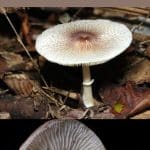

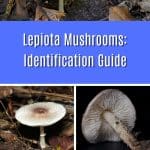
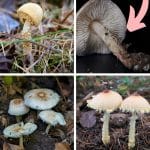



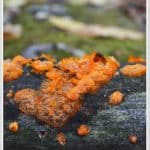
Leave a Reply